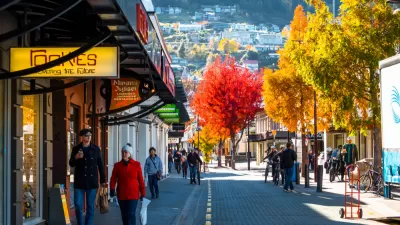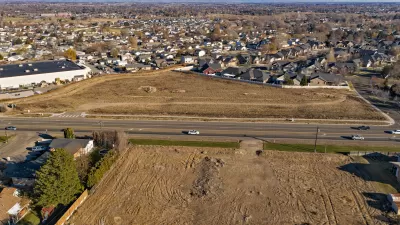The practice of limiting high-density development to busy arterial streets puts renters and low-income households at higher risk for the effects of air and noise pollution created on major roads.

Henry Grabar argues that policies that encourage higher-density development only on busy streets and commercial corridors amounts to discrimination against renters that perpetuates inequality. As Grabar puts it,
Unfortunately, big streets are not nice places to live. Their traffic is noisy, dirty, and dangerous. Allowing apartment buildings to be built at all is progress, but ensuring they rise only in the worst locations is not fair to the people who live in them.
The practice elicits less resistance from neighborhood groups that want to maintain single-family zoning, notes Grabar, "[b]ut that doesn’t mean it’s a good idea." While it's logical to build housing near transit, side streets in the same areas could also be upzoned to accommodate more housing. "Many critics have rightly pointed out, in recent years, that zoning in residential neighborhoods seems a lot more concerned with types of neighbors than with the supposedly hazardous consequences of their arrival." Meanwhile, planners concerned about additional traffic from high-rise buildings naturally lean toward placing them on busier roads, compounding the problem.
In an October article, Daniel Oleksiuk made a similar argument, calling for Vancouver to stop relegating multi-family dwellings to busy arterials and effectively turning renters into a 'buffer' for the pollution caused by crowded urban streets. According to Oleksiuk, while some people may choose to live on busy thoroughfares for the convenience, renter households should not be forced to suffer the brunt of urban pollution and public health hazards.
FULL STORY: Upzone the Side Streets!

Alabama: Trump Terminates Settlements for Black Communities Harmed By Raw Sewage
Trump deemed the landmark civil rights agreement “illegal DEI and environmental justice policy.”

Planetizen Federal Action Tracker
A weekly monitor of how Trump’s orders and actions are impacting planners and planning in America.

The 120 Year Old Tiny Home Villages That Sheltered San Francisco’s Earthquake Refugees
More than a century ago, San Francisco mobilized to house thousands of residents displaced by the 1906 earthquake. Could their strategy offer a model for the present?

Indy Neighborhood Group Builds Temporary Multi-Use Path
Community members, aided in part by funding from the city, repurposed a vehicle lane to create a protected bike and pedestrian path for the summer season.

Congestion Pricing Drops Holland Tunnel Delays by 65 Percent
New York City’s contentious tolling program has yielded improved traffic and roughly $100 million in revenue for the MTA.

In Both Crashes and Crime, Public Transportation is Far Safer than Driving
Contrary to popular assumptions, public transportation has far lower crash and crime rates than automobile travel. For safer communities, improve and encourage transit travel.
Urban Design for Planners 1: Software Tools
This six-course series explores essential urban design concepts using open source software and equips planners with the tools they need to participate fully in the urban design process.
Planning for Universal Design
Learn the tools for implementing Universal Design in planning regulations.
Clanton & Associates, Inc.
Jessamine County Fiscal Court
Institute for Housing and Urban Development Studies (IHS)
City of Grandview
Harvard GSD Executive Education
Toledo-Lucas County Plan Commissions
Salt Lake City
NYU Wagner Graduate School of Public Service





























